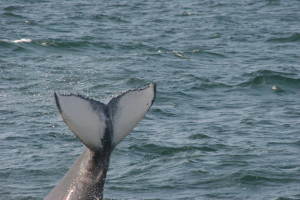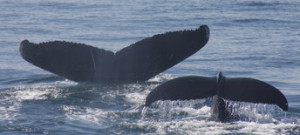Dolphin Fleet Naturalist Notebook 9 August to 15 August
August 9 was a beautiful day to be out on the water. The sun, the light breeze, and the abundance of humpback whales made for ideal conditions, and, in fact, once we got out to the Southwest corner of Stellwagen Bank, we spent the majority of the trip surrounded by humpback whales. Isthmus, Exclaim, Ember, Pogo, and Cirrus were some of the whales seen kicking, blowing bubbles, and then scooping up huge schools of fish, straining water out of their mouths through their baleen with every gulp.
Although large groups of humpbacks have the tendency to capture whale watchers’ attention, we had ample opportunity to get some great looks at fin whales near Race Point. In full view of sunbathers on Race Point Beach, we watched as several of these enormous animals spouted, surfaced, and dove with high arches of their backs. These animals are the second largest creatures to have ever graced the planet, and it is remarkable to think that that they can be seen in our waters all throughout the year!
On August 10 we ventured a bit farther to the west than normal, to the point where Plymouth Harbor was almost in full view. After watching approximately ten humpbacks, including Grackle, Coral, Ampersand and Tectonic feeding and traveling intermittantly, we came across a small humpback floating at the surface engaged in a resting behavior known as “logging.”
While we were pretty sure that this whale was a calf, its mother was nowhere in sight! In general, humpback whales stay with their mothers for about a year, and as most humpback whale calves are born in early winter, we knew that mom must be close-by. We figured that most likely, mom was on a deeper dive, maybe foraging for food, as the calf rested at the surface. During photo analysis, this young whale was determined t o be Dome’s most recent calf. We expect that next time we see this calf, mom will be at its side!
o be Dome’s most recent calf. We expect that next time we see this calf, mom will be at its side!
On August 11, we found a group of 8 humpbacks headed up by Freckles, a female humpback seen actively feeding during a majority of our whale watch trips over the past few weeks. Freckles was at it again this week, this time accompanied by Entropy, Polaris, Abrasion and Alpha, as well as some newcomers to the group, Pogo, Tunkguska and Soot. While many humpback whales tend to be solitary, only banding together for short periods of time to form small, unstable groups, Freckles has been seen on a regular basis with Entropy, Polaris, Alpha and Abrasion for over two weeks now!
By August 12 weather conditions had deteriorated significantly, but the rain didn’t prevent us from seeking out several different species of baleen whales. Remarkably, the morning trip on the Dolphin VII witnessed two different species of breaching whales. While it is not something we see every day, a humpback whale leaping out of the water is not an unfamiliar sight to many veteran whale watchers, and we started our day watching a humpback wha le calf do just this.
le calf do just this.
However, it is much less common to see the Minke whale leap out of the water, its short, white-emblazoned pectoral flippers pressed against its body. Most Minke whales seen in Stellwagen Bank are no more than 20 feet long, and for some reason, windier, rougher days seem to inspire this kind of behavior in them.
Later in the day, the skies cleared and the rain let up, and we got a chance to see another less frequently seen sea creature — the mola mola, otherwise known as an ocean sunfish. These unusual looking fish are considered by some to be the largest types of zooplankton. Their movements are largely dependent on currents, and as they drift along, they feast on comb jellies, salp, and other gelatinous delicacies in the water column. Weighing up to 600 pounds, mola molas are characterized by enormous triangle dorsal fins which jut out of the water. This was the first mola mola our naturalist had seen all year!
August 13th was calm and bright and we started the day watching a group of 4 humpbacks, comprised of two mother and calf pairs. While Canopy and Whisk, the adult females went on long dives, possibly foraging for food deep in the water column, their calves basked and rolled at the surface.
Canopy and calf
In the afternoon, we started our trip with a whale named Zeppelin who would kick feed every so often, but mostly appeared to be searching for food. We also noticed that Zeppelin had huge raw would along the right side of his jaw. This is a sign that Zeppelin has been foraging at the ocean floor. Using their jaws, humpbacks will frequently go right down to the sandy bottom to forage for sand eels that have buried themselves in the sand and mud. This tends to leave huge scrapes on their jawlines. Interestingly, in most of the population, these scrapes appear on the right jaw only. Just like most humans are right handed, most humpbacks are right jawed!
On August 14th we found ourselves back with the quartet of feeding humpbacks with Freckles at its core. However, Polaris seems to have been replaced by a whale named Centipede. Alpha and Abrasion remained, however, and the four of them continued to blow huge rings of bubbles in order to trap fish. These four whales were seen feeding throughout the day.
As morning fog gave way to bright skies, we got a chance to see several humpback whales right up next to the boat. One of them even rolled over enough that we got to see its eye peering right back up at us. While these whales have decent eyesight, their vision is limited by the murky, plankton-rich waters. These whales don’t have eyelids, but instead, their eyes are protected by a thick, oily film. In the photo below, notice that the whale’s eye is situated alongside its head, right above the jawline.
August 15th took us east of Stellwagen Bank, and along the way, we encountered several small humpbacks that are probably juveniles. While these whales don’t yet have names, next April all of the scientists that study this population will agree on appropriate names for those members of the population that have been seen for multiple years in a row. Eventually, we came across Apostrophe and her calf. While Apostrophe came up to the surface with her mouth wide open and full of food, her calf basked at the surface, knowing that it will probably get a good meal later on.

Apostrophe and calf
In the afternoon, we headed northwest toward Stellwagen Bank. Once we arrived on the bank, it was hard to know where to look first! On either side of the boat, there were humpback whales rolling over on their backs and slapping their flippers. With multiple flipper slappers in such close proximity, it seems reasonable to hypothesize that these whales could be communicating with one another through the loud, slapping noises their 15 foot-long flippers make as they hit the water.
During the evening trip we watched a rain storm sweep across the sky, although we managed to avoid it, we could still see it dropping showers further to the south. We did, however, have a rather unusual trip as we watched a very small Minke whale sidle right up to the Dolphin VI. Normally Minke whales are very evasive and fast, and as a result, we know very little about them, including where and when they calve. Naturalists aboard the Dolphin VI figured that this must have been a curious calf investing the boat. While this is relatively common among humpbacks, it is almost unheard of to get such a close approach from a Minke!







